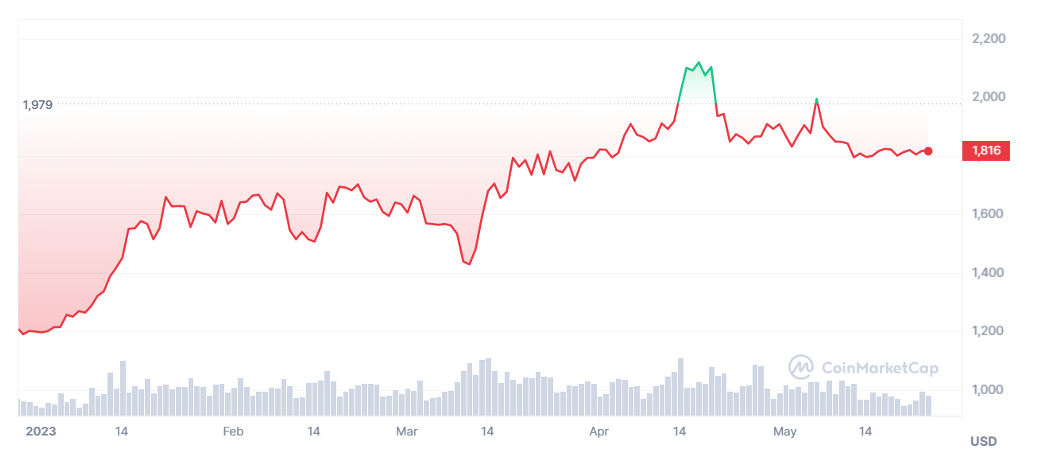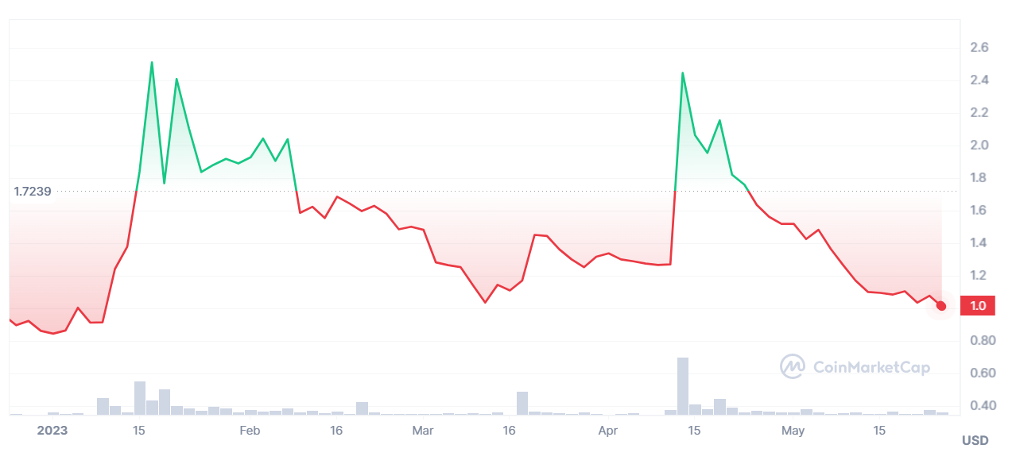
2023 Mid-Year Crypto Outlook
Crypto Trends to Watch & 2024 Bitcoin Halving
Topics discussed in the study:
Crypto Trends to Watch 2024 Bitcoin Halving is a 2023 Mid-Year Crypto Outlook by BITmarkets. The study outlines the major revelations of the cryptocurrency market since the start of 2023.
The almighty Bitcoin has propelled by over 60% after stumbling the past year. How realistic is an expectation that the current year may witness Bitcoin capture its shadowed all-time-high peeping into 2024 when its halving is awaited?
Reviewing the opportunities and risks surrounding crypto in such turbulent times is demanded not only by traders of BITmarkets but also by the wide and diverse audience engulfed within financial markets.
Dear friends,
The cryptocurrency market and related industries have undergone one turbulency after the next since the start of 2022, but ironically, these events contributed to building greater stability and ensuring higher transparency for the entire industry in the future. 2023 marked an exceptional year for the cryptocurrency market, with the market cap growing considerably throughout the year.
If you want to download this case study, here is a pdf version.
The following study summarizes recent revelations in crypto, explains their impact on major cryptocurrencies, and anticipates the risks and opportunities that could emerge in 2024 and beyond.
The year 2022 was a challenging one not only for the cryptocurrencies and related industries, but also for traditional and modern financial markets on a global scope. Russia’s invasion of Ukraine, pricy energy commodities and red-hot inflation have fundamentally affected markets in a negative way which damaged economies and led to resurgence struggles.
Such struggles remained omnipresent in 2023, yet investor and trader optimism brightened amid easing geopolitical and macroeconomic pressures. This has naturally reflected in the prices of individual stocks and cryptocurrencies. The market capitalization of both stocks and cryptocurrencies has grown throughout the year, but the value of crypto assets remains far from all-time highs.
The year 2023 seems to have blown a wind of change indeed, and the possibility of cryptocurrencies rocketing towards the highs of 2021 by 2024,  is quite valid given revitalizing market conditions. There are risks, or in other words, obstacles along the way, however, current market conditions may indicate a rather prosperous development and outcome for cryptocurrencies in the near future.
is quite valid given revitalizing market conditions. There are risks, or in other words, obstacles along the way, however, current market conditions may indicate a rather prosperous development and outcome for cryptocurrencies in the near future.

Peter Sumer
CEO
Why does crypto matter?
Cryptocurrencies came to light as a faster and cheaper way to transfer money in both centralized and decentralized scopes. Blockchain technology and the power of the internet have made it possible for digital assets to provide utility that can virtually benefit anyone. From a finance perspective, crypto assets offer a unique opportunity for investment in assets that are typically transparent, secure, highly-accessible and – for traders – very volatile.
Cryptocurrencies and the services & ecosystems linked to them have the potential to reshape the financial markets and other industries as well; just like how the internet did at the turn of the millennium. The crypto community is accelerating efforts towards building a range of technologies that can transform how we understand the world of finance. The range of new technologies that are a direct reflection of the existence of cryptocurrencies or the services associated with them is vast. These can be new & advanced forms of encryption, or smart contracts.
The cryptocurrency industry faced many challenges and obstacles in 2022, some of which still remain. Despite that, the current year has triumphed major cryptocurrencies including Bitcoin, Ethereum and Ripple, which in-turn championed digital asset investors and traders and revitalized the struck crypto ecosystem. One reinvestment after the next, the world of crypto is growing more advanced as fresh protocols that deliver more efficacy, accelerated operational ability and robust security levels are being introduced. The emergence of the metaverse phenomenon and the rise of artificial intelligence has also involved crypto elements, highlighting the significance of crypto in today’s day & age.
Discussed coins
Bitcoin (BTC)
Throughout the course of 2023, Bitcoin has climbed in value, setting higher highs and lows as it marches towards growth to price at nearly $27,000 at the time of writing. To put this into the context of significance and awe, this price-tag has been unwitnessed since mid-2022 after emerging in March.
After stumbling in 2022 to a demeaning $15,750 in November, outweighed by financial system slumps, geopolitical issues, higher inflation and hawkish central bank moves, the world’s favorite crypto, alongside the cryptocurrency market, has grown considerably as the outlook for the Federal Reserve policy tightening has evolved, eminent economic recessions became more possible & a lingering U.S. banking crisis pushed investors towards Bitcoin and other top cryptos (Duggan, 2023).
Fear and pessimism among investors have shifted to noticeable optimism towards cryptocurrencies. The banking crisis has presented cryptocurrencies, mainly Bitcoin, as a safer alternative to the calamitous impacts ensuing within the U.S. banking and finance sectors.
Going into 2024, Bitcoin is once again under the influence of regulatory scrutiny related to stablecoins that represent an integral part of the wallets of crypto traders as they rely on them to convert, purchase, and transact BTC and other popular cryptocurrencies.
Other revelations revolve around central bank digital currencies (CBDCs), which present a centralized digital currency, arguably as an alternative to Bitcoin. Should CBDCs launch into circulation and become more utilized by individuals & corporations, it may pose a risk to the adoption and utility of BTC.
On a more realistic note, Bitcoin took little time to cool off in 2023. This may indicate a foundation for a bull frenzy and higher buy power.

Bitcoin (BTC) Price Chart – 2023
Source: CoinMarketCap
Ethereum
Ethereum underwent a major facelift in 2022 when its verification mechanism changed from proof-of-work (PoW) to proof-of-stake (PoS). “The Merge” has also marked the beginning of a new era for Ethereum – but one that is provoking conflicting reactions as the PoS protocol reduces decentralization of the entire system, which has capabilities of facilitating future Ethereum regulations for governments.
Ethereum hit highs in May of last year, growing considerably during 2023 by more than 50% to more than $1,800 per ETH. The mother of all crypto coins has noticeably soared in April following its “Shapella” upgrade, which was bound to enhance ETH’s mainnet performance, security layers, and efficiency (Maheshwari, 2023).
Another major revelation surrounding Ethereum was increasing gas fees due to the rise of memecoins and the frenzy that came with it, giving notable rise to Pepe the Frog (PEPE), which, rather quickly, fell into oblivion one day after the next.
The Shapella Upgrade
In mid-April of 2023, the renowned Ethereum blockchain implemented the much-awaited “Shapella” upgrade which boosts ETH mainnet performance, security protocols an operational efficiency, but can also play a role in lowering gas fees for operations of layer-2 solutions.
This presented Ethereum as an appealing blockchain with less costs for traders and accelerated transaction speeds, which in turn boosted the value and attractiveness of the ETH coin.

Ethereum (ETH) Price Chart – 2023
Source: CoinMarketCap
Ripple (XRP)
The main advantage of XRP is the Ripple payment protocol the token is a part of. In the future, Ripple may serve as an alternative to the traditional SWIFT system for cross-border transfers currently adopted by traditional banks and other major entities. Ripple appears to present a more cost-effective and faster option to SWIFT and could even replace it in the future, which would positively reflect in XRP’s prospective price.
A major issue for Ripple Labs since 2020 has been a lawsuit by the United States Securities and Exchange Commission (SEC) alleging that the company sold up to $1.3 billion worth of unregistered securities through XRP. The lawsuit and the potential fine associated with it have caused considerable distrust among potential investors.
The United States District Court in the Southern District of New York ruled in favour of Ripple Labs on July 13, 2023. According to documents filed, the judge has granted summary judgment in favour of Ripple Labs, ruling that the XRP token is not a security in regards to programmatic sales on digital asset exchanges. The SEC lawsuit sought to compel Ripple to stop offering its XRP token under the premise that XRP was a security and, thus, required additional regulation.
The judgment means, XRP shall get rid of the main sources of uncertainty about its future direction, and it can be expected that its price would rise in the coming years.
Terra/Luna
The Terra system was one of the most interesting and popular systems on the cryptocurrency scene in 2021, competing for the big bucks with traditional financial behemoths. The principle was simple; its stablecoin TerraUSD (UST) was to be held at 1 UST = 1 USD and in case of deviation, the token Luna (the primary backing asset for Terra) would help it return to its original level by burning. *
What the system did not count on, however, is the panic that would grip investors if the UST deviated further. This is exactly what happened in April 2022. It was essentially an attack on the currency we are familiar with from the traditional money environment. The UST deviated from the USD up to the level of 0.35 UST = 1 USD, which Luna could not cover and subsequently lost up to 99% of its value.
The fall of such a promising project was reflected in investor sentiment. This, combined with the situation in the mainstream financial markets, led investors to perceive cryptocurrencies as too risky. Such crisis of confidence was followed by a further decline in the prices of the majority of crypto assets.
The year is 2023, and while both cryptocurrencies linked to Terra technology, Terra Classic (LUNC) and Terra (LUNA), have grown considerably during the first months of 2023 amid the bullish power overtaking the crypto markets, they have dwindled and weakened as the community has evidently lost hope in the once-pioneering stablecoin.
* Coin burning is a technique used by the cryptocurrency community when reducing the supply of a particular cryptocurrency. There can be various reasons, such as trying to increase its price. In the case of stablecoins, it serves the purpose of maintaining parity with the pegged currency. If the price of a stablecoin deviates too far upwards, new tokens are issued; if it deviates too far downwards, burning occurs. This is performed, for example, by sending already issued tokens by the user to a wallet that only has the ability to receive cryptocurrencies but not send them, effectively withdrawing received tokens from circulation.
Mt. Gox
The Mt. Gox exchange was once the largest in the market, and when it collapsed in 2014, roughly 850,000 Bitcoins were lost. Till this day, it still remains the largest crypto robbery in history.
A saga that continues to exist; the creditors of the fallen cryptocurrency exchange are seeking repayment, and the exchange will provide base repayments, intermediate repayments and early lump-sum repayments to creditors until the 31st of October, 2023.
Being a hot topic on the crypto scene, it is still of significance as it affects the price of Bitcoin and other major cryptocurrencies. After reports indicated that wallets linked to the defunct crypto exchange Mt. Gox and the U.S. government had shifted large amounts of Bitcoin (Graves, 2023), towards the end of April, Bitcoin plunged as much as 7% in one hour. The Mt. Gox conundrum is expected to remain impactful on the crypto market for the foreseeable future.
FTX
FTX was once the world’s 2nd largest crypto exchange, and its story says the following: there’s nothing called too big to fail in such a young market. The crypto industry continues to lack strong institutional foundations, especially in terms of transparency and public scrutiny. The founder of the exchange, Sam Bankman-Fried (SBF), has become an infamous figure in many eyes.
Another company founded by SBF called Alameda Research was independent of FTX. However, in early November of 2022, cryptocurrency news outlet Coindesk reported that the two companies were closely intertwined, and that Alameda Research had assets of roughly $14.6 billion. Most of the assets were held in the FTT token, which was a product of FTX (Allison, 2022). Following the announcement that Binance would sell its roughly $2 billion-worth of FTT tokens, there was a sample case bank run, which FTX was unable to withstand as it could not pay investors back.
The exchange issued a statement discouraging potential investors from depositing on the exchange and freezing all withdrawals. Again, like the collapse of Project Terra, the collapse of FTX had a negative impact on the overall market, and the prices of individual cryptocurrencies dropped noticeably.
Fast-forward to late May of 2023, after being hunted down by the United States Internal Revenue Service (IRS) for billions of dollars related to the exchange’s bankruptcy, rumors to reboot the fallen exchange are becoming more of a reality, and plans are being plotted down by FTX CEO John Ray III.
News of the relaunch of FTX, or FTX 2.0, has circulated, which has boosted the price of the FTT token by 12% within 24 hours, and the increased trading volume, reaching $27.2 million, reflects heightened activity from speculators (Surya, 2023).

Ripple (XRP) Price Chart – 2023
Source: CoinMarketCap
What’s next for crypto?
2023 has started strong for cryptocurrencies and other financial market assets, combatting headwinds with fierce force, and retaining hard-earned value. There are several trends of the current year and the ones to follow: more regulation, the rise of central bank digital currencies, the popularization of DeFi, more investments in stablecoins and the revitalization or deterioration of NFTs.
More Regulation
Identity verification strictness may increase as more cyberattacks and hacks have been noted recently. Increased regulation is intended to safeguard crypto traders’ funds and data. This can come in the form of increasing scrutiny of identity verification, which can bolster the effectiveness of regulatory frameworks set in place.
More than $2.1 billion worth of crypto assets were stolen in 2022. Other legal measures such as passing new laws which tackle money laundering and necessitating accurate & recurrent corporate reporting can achieve higher consumer protection.
Rise of CBDCs
Central banks from around the world are exploring ways to launch central bank digital currencies (CBDCs) in ways that can predominantly benefit the nation’s money flows. The implementation of government-monitored digital currencies on a national scale will boost protection from cyberattacks, at the expense of less anonymity and privacy for the everyday crypto trader.
Major CBDC developments are occurring in the United States. Other nations all around the world, including China, Japan, and The United Arab Emirates (UAE), are also doubling-up on research & development to find effective ways to adopt and use CBDCs in everyday life.
Popularization of DeFi
Decentralized Finance (DeFi) is the backbone of cryptocurrencies and may remain so for many traders, investors, and corporations in the crypto community. The rise of Web3 will be a driver to DeFi development as it carries the potential to leverage the capabilities of DeFi.
It is worth mentioning that the rise of DeFi would present a hurdle to implementing more regulation and launching CBDCs. This shows that not all initiatives strive for the same goals & outcomes. Since many corporations, protocols and projects are investing billions of dollars towards developing the new version of the internet, Web3, the capabilities of DeFi may increase in the years to come.
While both strive to achieve distinct end-results, there can be rises in centralization & decentralization at the same time, and only a test of time would reveal which of the two will add more aggregate benefit.
More Stablecoin Investments
Stablecoins have settled in the majority of crypto traders’ wallets, as they are needed for many reasons. Stablecoins present a hedge against inflation, promise stability in the value of digital assets, facilitate as a direct link to traditional markets, and act as a handy asset that can be easily converted to fiat and cash.
Without stablecoins, it’s increasingly difficult for investors and traders to cash out on gains. The importance of major stablecoins is expected to grow in the new chapter crypto is entering. If cryptocurrency market activity grows, so will stablecoins like Tether, USDC, Dai, and True USD. However, not all digital assets may see the bright side of the day, which brings us to the everlasting conundrum of nonfungible tokens, or NFTs in short.
NFTs – Are They Still Relevant?
NFTs were the hot topic one day. From the 1st quarter of 2020 to the first quarter of the following year, sales of NFTs from images & videos to in-game items skyrocketed 131 times, recognizing $2 billion in sales. However, it wasn’t all sunshine and rainbows for the digital assets of crypto fanatics and collectors.
NFT markets sustained a heavy blow in 2022, with volume traded per week hampered by more than an 80% decline from year highs hit in mid-May of 2022. Yet, NFT activity remained impressively steady in the first half of 2022 before slumping throughout the year’s remaining months.
Once an attractive asset, NFTs have devolved from an attractive asset to one that’s arguably seen as a nuisance amid harsh market conditions which grew attached to pessimism and skepticism towards NFTs. The NFT conundrum remains prevalent, but the trading volume of NFTs has been somewhat steady in 2023 amid the bullish rally of major cryptocurrencies.
According to NFTNDX.IO, authenticated NFT daily transfer activity surged in 2023 to levels unseen since mid-2022, showcasing signs of growth since the final months of 2022. NFTs have also enjoyed more attention from behemothic firms like Amazon & eBay, indicating that NFTs remain relevant.
2024 – Major bitcoin halving
Looking ahead into the horizons of 2024 and beyond, Bitcoin is set to undergo a periodic halving event which occurs every 4 years or 210,000 blocks on the Bitcoin blockchain. The initial block reward for BTC was 50 BTC, while the current block reward stands at 6.25 BTC, and the next block reward will be 3.125 BTC, and the halving continues.
This event, programmed into the Bitcoin code, slows down the rate at which Bitcoins are mined and generated. The main incentive behind this action is to limit the total supply of BTC, which shall be maxed out at 21,000,000 BTC.
By comparing the mechanisms of BTC with traditional financial systems, we see that printing fiat money, which increases supply, causes inflation, while reducing BTC supply – given strong demand – would boost its value. This makes Bitcoin similar to gold, which has limited supply that cannot be increased.
Last year, cryptocurrencies including Raven (RVN) and Dash (DASH) underwent a halving event, and in August of this year, it’s time for Litecoin (LTC) supply to be slashed by half. Such events keep cryptocurrency assets valuable through the simple forces of demand and supply.
About BITmarkets
Fascinated? Interested in new opportunities emerging from the crypto world?
Our committed colleagues are available for your questions.
+44 20 4579 5923 (24/7)
www.bitmarkets.com
BITmarkets brings a new approach to crypto exchange for retail and corporate clients.
We open up the existing cryptocurrency markets to everyone and everywhere. We do not mean just simple accessibility of trading via apps or websites. We aim for the mass adoption of crypto by making it simple, secure, and trustworthy.
We go beyond basic customer service by offering a helpline in over 16 languages that works non-stop to ensure that traders can fully benefit from a wide range of products and features.
We strive to integrate digital assets with the existing financial world infrastructure, leveraging cryptocurrencies’ decentralization to increase convenience and accessibility. The BITmarkets Exchange is joined by a suite of financial services that complement each other and enhance your personal and professional finance experience.
99.9 %
of Funds in Cold Storage
Near 0
Near-Zero Downtime with Hot Upgrades
1 Million +
Order Request(s)
Fully Self-Hosted
Infrastructure
Quoted by:
Bibliography
Allison, I. (2023) 'Divisions in Sam Bankman-Fried’s crypto empire Blur on his trading Titan Alameda’s balance sheet', CoinDesk. Available at: https://www.coindesk.com/business/2022/11/02/divisions-in-sam-bankman-frieds-crypto-empire-blur-on-his-trading-titan-alamedas-balance-sheet/
Duggan, W. (2023) 'June 2023 crypto market forecast', Forbes. Available at: https://capital.com/ripple-sec-suit-decision-timing-xrp-details
Graves, S. (2023) 'Bitcoin plunges 7% in an hour to under $28,000 as ‘Mt. Gox alert’ causes confusion', Decrypt. Available at: https://decrypt.co/138086/bitcoin-plunges-7-in-an-hour-to-under-28000-as-mt-gox-us-gov-wallets-move
Maheshwari, R. (2023) 'Why is Ethereum going up today?', Forbes. Available at: https://www.forbes.com/advisor/in/investing/cryptocurrency/why-is-ethereum-going-up
Sanis, R. and Henn, P. (2023) 'Ripple/SEC lawsuit: news and update', Capital.com. Available at: https://capital.com/ripple-sec-suit-decision-timing-xrp-details
Surya, P. (2023) 'FTX 2.0 reboot possibility surges FTT token by 12%', The Crypto Times. Available at: https://www.cryptotimes.io/ftx-2-0-reboot-possibility-surges-ftt-token-by-12/
'Leading cryptocurrency platform for mining and trading' (no date), NiceHash. Available at: https://www.nicehash.com/countdown/btc-halving-2024-05-10-12-00
© 2023 BITmarkets. All rights reserved.
Crypto assets as unregulated, decentralised and highly volatile assets entail substantial risks, and you may lose all invested capital.
.webp)
-(1).webp)





